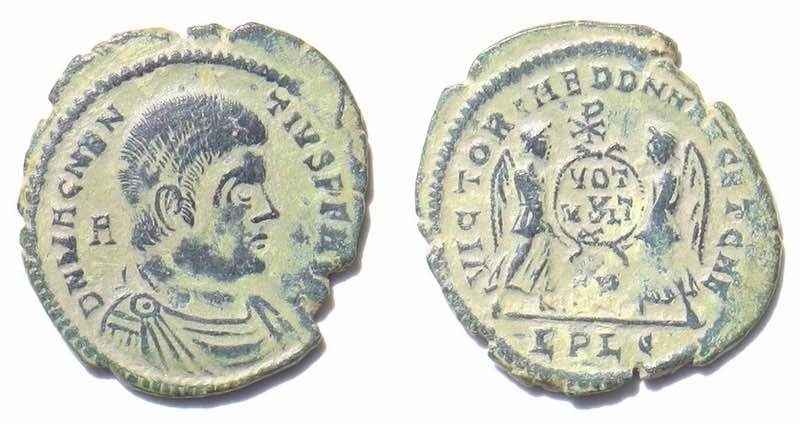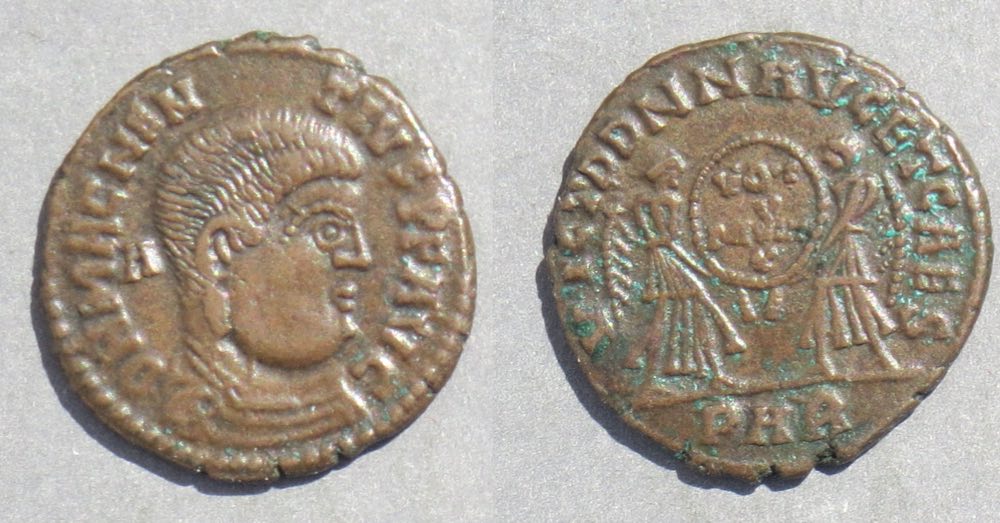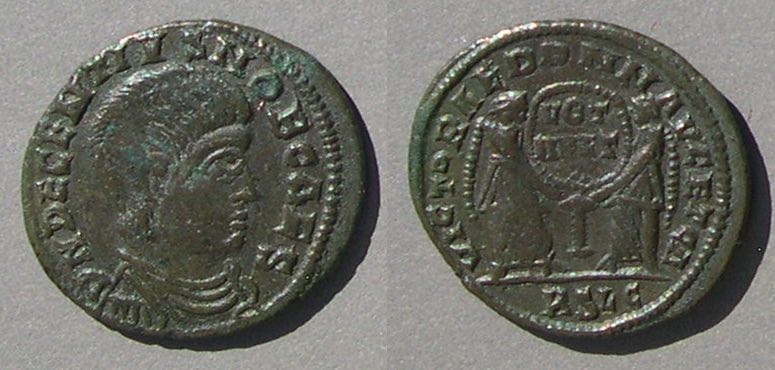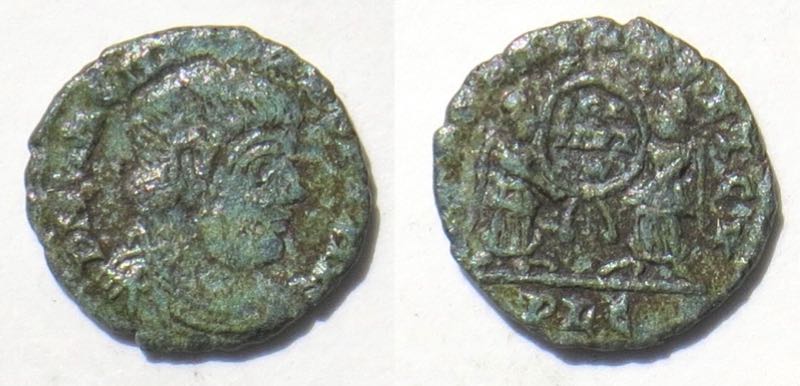 Vota coins of Magnentius and Decentius, 350-353
Vota coins of Magnentius and Decentius, 350-353Magnentius overthrew Constans in 350 in Gaul and a year later elevated his brother Decentius to Caesar. His most common type (to the right) is a vota type also issued for Decentius.
 Vota coins of Magnentius and Decentius, 350-353
Vota coins of Magnentius and Decentius, 350-353
Magnentius overthrew Constans in 350 in Gaul and a year later elevated his brother Decentius to Caesar. His most common type (to the right) is a vota type also issued for Decentius.
Magnentius. AE2. 24-23 mm 4.30 grams.
DN MAGNENTIVS PF AVG, bare-headed, draped, and cuirassed bust right, "A" behind.
Two victories holding a shield inscribed VOT/V/MVLT/X
VICTORIAE DD NN AVG ET CAE around
chi-rho above shield, LPLG for Lugdunum in exergue
RIC VIII Lugdunum 140.
RIC dates this type to the entire period of his reign.
Under the late empire numbers for suscepta were often taken for one year and "multiplied" to a second. The practice was common on coins of the Gallic usurpers Magnentius and Decentius and later emperors.
Dating Coins of Magnentius. Magnentius ruled 19 January 350 to 18 August 353, so his fifth year would have begun 19 January 354, but he didn't last that long. Decentius was elevated in Spring 351 and issued the same type, so the numbers on his coins belong to Magnentius. In the second and third centuries vows mentioned ten years, but not five. It may be that all the short reigns prompted emperors to think they should pay the gods more quickly lest the gods think protecting the emperors was too much work for a payoff delayed until the tenth year. If this type records, as seems likely, vows suscepta for both five and ten years at the beginning of the reign, it respects the traditional tenth-year vows and, in addition, promises an earlier payoff.
Suscepta or Soluta? Most types with "VOT" do not explicitly distinguish whether they are suscepta or soluta. it often takes numismatic analysis to tell, and some coin types are issued well before the event mentioned. If a reign begins in 350 it does not begin its fifth year until 354 and Magnentius and Decentius did not make it to 354. There are at least three possible explanations:
1) The type was issued in anticipation of the "5 years" event and the vows were for intended five years soluta and for ten years suscepta,
2) The vows were taken, suscepta, for both 5 and 10 years at the same time, beginning near the beginning of the reign, and the type was continued after the initial ceremony,
3) Magnentius and Decentius issued vows coins without regard to correct timing of the vows ceremonies.
John Kent, author of RIC VIII, chose option 2 and has this type issued throughout the reigns of both Magnentius and Decentius.
 Decentius, 351-353
Decentius, 351-353
AE2. 21 mm. 5.42 grams.
VOT/V/MVLT/X on shield
held by two Victories
VICTORIAE DD NN AVG ET CAE around
S V low in middle in field
RSLG in exergue
RIC VIII Lugdunum 127 "Spring 351 - 18 August 353"
Imitations. The types of Magnentius and Decentius were commonly imitated. Some imitations were full sized and nearly official style, but they soon became smaller, cruder, and unmistakably unofficial.
 Magnentius imitation
Magnentius imitation
20 mm. 3.72 grams
Nearly full size and fairly good style
These must have been produced to meet the demand for more small change, not because the was great profit in counterfeiting them.
Cf. RIC VIII Arles page 216.
cf. Bastien Magnentius 254, plate IV for mint and control marks and imitations #47 plate XVIII for one like this, but this one is in better style.
 Decentius imitation
Decentius imitation
22 mm. 3.51 grams.
A full-sized imitation.
Mintmark AMB of Amiens.
RIC Amien 6 as prototype, however with "S V" across the field like issues of Lugdunum.
 Decentius imitation
Decentius imitation
19-18 mm. 5.42 grams.
Full weight, but smaller diameter than official coins.
Shield inscribed only
VOT MVLT X (The "X" is very weak)
VICTORAE [sic] DD NN AVG ET CA [sic]
RSLG in exergue
RIC Lugdunum 122 for the prototype.
 Magnentius imitation
Magnentius imitation
Tiny. 14-13 mm. 1.08 grams.
Small ancient imitation with dies that fit the small flan
PLG in exergue
RIC VIII page 187 lists "14-15 mm" well-executed, rare, examples with a longer mintmark and letters in the field. This example is smaller. It has the typical English heavy green patina. Small late Roman copper of the late FEL TEMP REPARATIO period are found by the thousands in England and a very small fraction of them are imitations of Magnentius.
Continue with vota coins of Julian II and Jovian.
Return to the main page on vota coins.
Leave the pages on vota coins and go to the main Table of Contents page for this whole educational site.